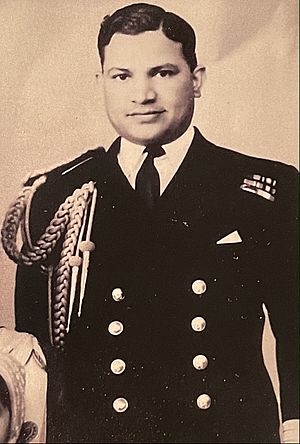Ajitendu Chakraverti facts for kids
Quick facts for kids
Rear Admiral
A Chakraverti
|
|
|---|---|
 |
|
| Nickname(s) | Aton |
| Born | 3 February 1914 Ajmere, India |
| Died | 16 October 1995 (aged 81) Delhi, India |
| Buried |
Ashes scattered in Indian Ocean
|
| Allegiance | |
| Service/ |
|
| Years of service | 1928–1963 |
| Rank | |
| Commands held | Indian Fleet Bombay Command 11th Destroyer Flotilla INS Rajput (D141) HMIS Himalaya HMIS Rajputana (J197) |
| Battles/wars | World War II |
| Awards | Mentioned in dispatches |
Rear Admiral Ajitendu Chakraverti was a very important officer in the Indian Navy. He was the second Indian to lead the Indian Fleet. He also made history as the first Indian to become a Commodore in the Royal Indian Navy.
Contents
Starting His Journey
Ajitendu Chakraverti joined the Indian Mercantile Marine Training Ship Dufferin in 1928. This ship was set up to train young people for India's marine service. He was part of the second group of cadets to join. In 1930, he finished his training and won the Viceroy's gold medal.
One of his classmates was Bhaskar Sadashiv Soman, who would later become the Chief of the Naval Staff. They had a friendly competition throughout their careers. After Dufferin, Chakraverti joined the Royal Indian Marine (RIM) as a cadet. He trained in the United Kingdom for three years. He served on ships like HMS Erebus (I02) and HMS Frobisher (D81).
He became a sub-lieutenant in the RIM in 1934. Soon after, the RIM changed its name to the Royal Indian Navy (RIN). He was promoted to Lieutenant in 1937.
World War II Service
When World War II began in 1939, Chakraverti went to the UK for special gunnery training. He returned to India in 1941. He became the second-in-command of the RIN Gunnery School in Bombay. In 1943, he was promoted to acting Lieutenant Commander. He then worked as a Staff Officer for Gunnery at Naval Headquarters.
In 1944, he took command of the minesweeper HMIS Rajputana. He helped clear mines near Burma and the Malacca Strait. For his excellent service during the war, he was recognized in June 1946. He also led the Navy's group at the London Victory Celebrations of 1946.
After the war, he attended the Royal Naval College, Greenwich in 1946. When he came back to India, he became the Commanding Officer of the gunnery school, HMIS Himalaya, in Karachi. In 1947, he was promoted to acting Captain. He then became the Chief of Administration (COA) at Naval Headquarters.
After India's Independence
After India became independent in 1947, Chakraverti continued as Chief of Administration. In 1948, he became the acting Chief of Staff at Naval Headquarters. He was promoted to Commodore 2nd Class in May. This made him the first Indian officer to reach such a high rank.
In November 1948, Chakraverti went to the United Kingdom. India was buying three destroyers from the UK. These ships were renamed INS Rajput (D141), INS Ranjit (D209), and INS Rana (D115). Chakraverti became the Commanding Officer of the Rajput. He also led the 11th Destroyer Flotilla, which was a group of these ships.
The flotilla trained with the Mediterranean Fleet of the Royal Navy. Chakraverti's flotilla was considered the best among all British and Commonwealth destroyer groups in the Mediterranean.
In 1950, the flotilla arrived in Bombay. Chakraverti was promoted to captain in December 1950. In 1951, he left command of the flotilla. He then took on an important role as Captain Superintendent of the Indian Naval Dockyard in Bombay.
In 1953, he was appointed the next Commodore-in-Charge Bombay (COMBAY). He was the first Indian officer to hold this position. This role later became a Rear Admiral position. In 1954, he attended the Imperial Defence College in the UK. After his course, he returned to India. He became the Deputy Chief of the Naval Staff in 1956.
Leading the Fleet
In February 1958, Chakraverti was chosen to be the Flag Officer Commanding Indian Fleet (FOCIF). He was the second Indian officer to lead the Indian Fleet. He was promoted to acting Rear Admiral on February 8. On April 2, 1958, he officially took command. He flew his flag on the new flagship, the cruiser INS Mysore (C60).
Soon after taking command, he led the Indian fleet in joint exercises. These exercises were with other Commonwealth navies off Ceylon. The fleet included the flagship Mysore, the light cruiser INS Delhi (C74), and several destroyers and frigates. They trained with the Royal Navy, Royal Ceylon Navy, and Pakistan Navy.
In June 1959, Chakraverti led the fleet on a ten-week exercise. The ships visited ports on India's east coast and the Andaman Islands. In August, the fleet trained with the Royal Navy near Cochin. Chakraverti even directed these exercises from an aircraft! In March 1960, he led the largest joint Commonwealth exercises to date. Many navies, including those from Australia, New Zealand, and Malaysia, took part.
Later Years and Retirement
Chakraverti left command of the Indian fleet in April 1960. In the same month, the National Defence College (NDC) was opened by Prime Minister Jawaharlal Nehru. Chakraverti was chosen to be the first Naval Senior Directing Staff (SDS) at the NDC. He helped guide the first two courses at the college. He retired from the Navy in June 1963.
See Also
- Admiral Bhaskar Sadashiv Soman
- Flag Officer Commanding Indian Fleet
Images for kids


